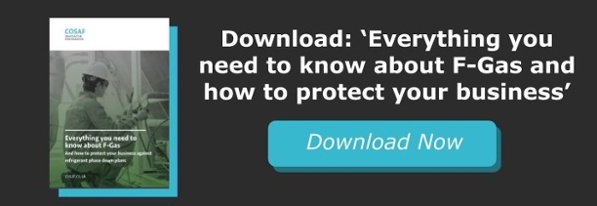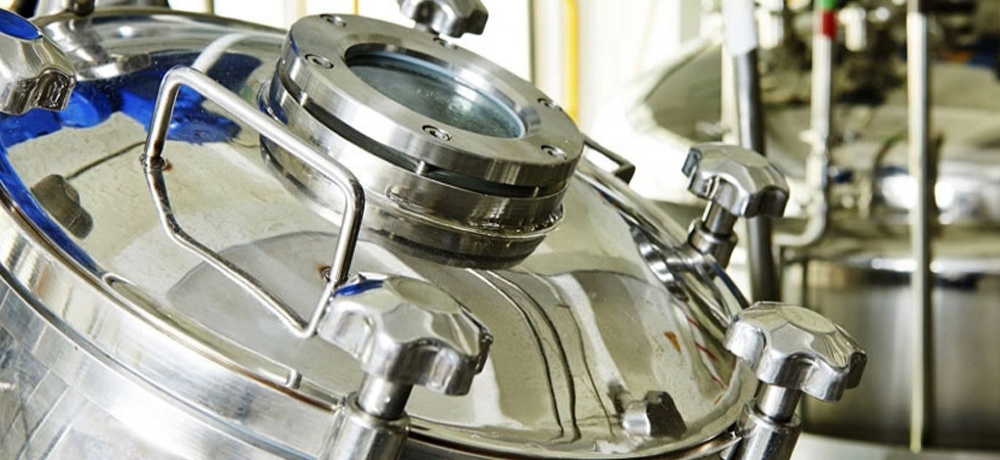Simon Ravenscroft, Regional & International Sales Manager at National Refrigerants, gives exclusive interview for Cosaf on the issue of F-Gas.
National Refrigerants is a very well respected company established in 1983 within the UK to supply Europe and the rest of the world's markets with refrigerants and associated products and services. During this 30 year period, the company has grown to become one of Europe’s largest independent suppliers of refrigerants worldwide servicing over 40 countries.
Could you give us an outline of what are the F-Gas regulations and how they came to be?
The F-Gas regulations were introduced in 2006 to regulate the use of Fluorinated Gases (F-Gases). Fluorinated gases are man-made greenhouse gases that contribute towards global warming. F-Gases can include hydrofluorocarbons (HFCs), perfluorocarbons ( PFCs ) and sulphur hexafluoride (SF6).
The purpose of the regulations is to ensure that only qualified people can work with these gases to ensure wherever practicable that these gases are not released into the atmosphere.
Prior to 2015 there were no restrictions on the manufacture or importation of HFC refrigerants into Europe. As part of Europe’s plan to reduce global warming, the European parliament revised the F-Gas legislation to control and reduce HFC production. To do so, in 2015 a new quota system was introduced limiting who can manufacturer or import HFCs into Europe. It is important to understand that this quota system is not a physical kg based system, but a CO₂ equivalent.
All HFCs have a GWP (Global Warming Potential) number based on how much it contributes to global warming if released into the atmosphere. As an example R404A - traditionally used in supermarket fridges and refrigerated transport - has a GWP of 3,922. To put that into context, CO₂ has a GWP of 1.
This now means that the higher GWP gases consume quota at a much higher rate.
The quota restriction has set reductions between 2015-2030 when the final cut comes in at just 21%. This means that manufacturers need to produce refrigerant fluids that have a lower GWP and European consumers have to change to them.
What change have you seen since the regulations have been implemented?
There have been two significant changes since 2015. The first is availability. In 2016 we saw the first 7% reduction of gas quota and then in 2017 pre-charged equipment was introduced (previously exempt for 2 years).
Pre-charged equipment is defined as goods manufactured containing HFC gases. From 2017 onwards any manufacturer importing these goods from outside of Europe now has to purchase quota from a quota holder to cover the gas in the equipment. So, although there was no reduction in 2017 there was, in actual fact, extra demand placed on the existing quota. This has been estimated at somewhere between 10% and 20% of the total volume of gas consumed in Europe. In 2018 we see the most significant reduction to date at 63% of 2016’s 93%, including an extra demand for pre-charged equipment.
This, of course, has led to the second significant change – price. Over the last couple of years prices have increased 200%-600% depending on the gas. Higher GWP gases have been subject to the highest increases as they consume more of the quota. As more reductions are introduced the price will only continue to increase.
What implications are there to business?
There are numerous implications to many types of business, such as increasing costs to install and maintain air-conditioning or refrigerated systems.
Worse still, when the weather gets warmer and the demand for these products increases some consumers could find themselves in a position where they have to wait for products to become available to repair broken systems or, even worse, may not be able to get them at all.
What are the potential risks/implications that people aren't considering?
At the moment customers are so fixated on pricing they are not considering the bigger picture, this year’s cut will certainly lead to supply issues for some, the price is completely irrelevant if you can’t actually buy it.
Can you tell us about the current gas quota for manufacturers and how this is scheduled the progress?
|
Years: |
Percentage of Original amount permitted: |
|
2015 |
100% |
|
2016-17 |
93% |
|
2018-20 |
63% |
|
2021-23 |
45% |
|
2024-26 |
31% |
|
2027-29 |
24% |
|
2030 |
21% |
It is important to understand that these published cuts do not include the demand for pre-charged equipment and where it states “Percentage of original amount permitted” the 2018-20 63% is actually 63% of the previous 93% and the 2021-23 45% is 45% of the previous 63% on so on.
How do you predict the changes in quota is going to affect your clients and companies in general?
The changes in quota will primarily impact every user financially. Long gone are the days where installers can quote installation’s with fixed prices for 6 months. When quoting these jobs, it is important to understand the cost of the refrigerant for that job is only valid for the same month as it is produced.
Contractors of large jobs in particular that will require a large amount of refrigerant are especially vulnerable as the larger the gas volume, the harder it will be to guarantee availability when it’s required.
During a training session we held at Cosaf on the issue of F-Gas, you mentioned that these rapid quota reductions could lead to a potential disaster if a large facility was to run out of gas, could you please go into more detail about this?
As this year’s cut is so big, it is genuinely plausible to say that this year there might be contractors that will not be able to get the products they want when they want them. If that contractor happens to service a large cold store or supermarket what do they do if they have no access to the gas their client needs?
What alternatives are there to high GWP gases?
There are a number of low/lower GWP options available on the market, but they all come with their own issues. Hydrocarbons R290/R1270 have a very low GWP, but are also very flammable. Ammonia’s GWP = 0, but the substance is highly toxic and corrosive. Co2’s GWP = 1, but has very high pressure. Each one leading to serious safety implications that make the product less than ideal as a replacement.
There are now new lower GWP fluids coming to the market called Hydrofluoroolefin’s (HFO), but most of these blends have been classified as A2L mildly flammable. The problem with these types of refrigerants is that as you reduce the GWP you start to increase the flammability.
What are the pros and cons of those alternatives? Would any of them serve as long-term solutions, if not, what would you consider as the best long-term solution?
Certainly Co2, Ammonia, Hydrocarbons are long term solutions where their safe application permits their use along with some of the HFO replacements for R134A (R1234yf & R1234ze),but it is still early days for genuine low GWP replacements for most of the mainstream gases. There are lower GWP alternatives for R404A available now, but these are only interim solutions as their GWP is not low enough for the continued quota cuts.
There is R32 available now for new air-conditioning equipment, which is approx. 70% lower in GWP than R410A (GWP 2088), but the gas cannot be used in existing R410A equipment as it is A2L mildly flammable. It is also worth noting that R32 with a GWP of 675 is still not a long term solution. To be considered a genuine low GWP product with a long term future, the GWP really has to be below 150.
Is there any advice or guidance that you could give to companies in regards to next steps on how to protect their business and adapt to the changes?
The only real way protect against these changes is good maintenance, if your equipment doesn’t lose its gas you won’t need to replace it.
Keep up to date, talk to your supplier/contactor and get them to keep you informed of any changes, whether that’s pricing, availability or new products that can replace existing refrigerants in your equipment. Read the many trade publications widely available.
Is there anything else that you would like to warn our audience about?
It is also important to be aware of other changes, such as introduction on bans on certain gases in certain equipment like the service ban on equipment containing refrigerants with a GWP over 2,500 in 2020 using virgin gas along with others listed below.
|
Products and Equipment: |
Date of Prohibition: |
|
Domestic refrigerators and freezers that contain HFCs with GWP of 150 or greater |
January 1st 2015 |
|
Refrigerators and freezers for commercial use (hermetically sealed systems) containing HFCs with GWPs of 2500 and over |
January 1st 2020 |
|
Refrigerators and freezers for commercial use (hermetically sealed systems) containing HFCs with GWPs of 150 or greater |
January 1st 2022 |
|
Stationary refrigeration equipment that contains, or that relies upon for its functioning, HFCs with GWPs of 2500 or greater (except equipment for temperatures below -50 deg C) |
January 1st 2020 |
|
Multipack centralised refrigeration systems for commercial use with a capacity of 40 kW or greater that contain, or that rely upon for their functioning, fluorinated greenhouse gases with GWP of 150 or greater (except in the primary refrigerant circuit of cascade systems, where fluorinated greenhouse gases with a GWP of less than 1500 may be used) |
January 1st 2022 |
|
Movable room air-conditioning appliances (hermetically sealed equipment which is movable between rooms by the end user) that contain HFCs with GWP of 150 or greater |
January 1st 2020 |
|
Single split air-conditioning systems containing less than 3 kg of fluorinated greenhouse gases, that contain, or that rely upon for their functioning, fluorinated greenhouse gases with GWP of 750 or greater |
January 1st 2025 |
Service and Maintenance Ban
|
Products and Equipment: |
Date of Prohibition: |
|
The use of all VIRGIN Refrigerants with a GWP of 2500 or greater to service existing equipment with a charge size of 40MT CO2e or greater |
January 1st 2020 |
|
The use of all RECLAIMED Refrigerants with a GWP of 2500 or greater to service existing equipment with a charge size of 40MT CO2e or greater |
January 1st 2030 |
Cosaf's advice
Our advice is simple: look to reduce or remove refrigerants where possible. The rapid advancement of technology and the introduction of new, far more energy efficient and environmentally friendly solutions, make the replacement of high GWP gases with other high GWP gases redundant.
One example of an ideal solution is Air2O, a next generation of ultra-efficient, packaged air conditioning and heat recovery systems. At its heart Air2O uses a 3 stage evaporative cooling technology - indirect, direct and hybrid - which can automatically respond to external weather conditions, switching from evaporative cooling to low GWP air conditioning only when needed. The system is able to deliver consistent performance, high efficiency and significant energy savings of over 80%. Find out more about Air2O here.
This, of course, is not your only option. If evaporative cooling is not right for you, there are plenty of other HVAC products and solutions that can be utilised to help you for what’s coming next. All you need is an experienced supplier that has the necessary knowledge and qualifications to provide you with an intelligent cooling and heating alternative.
Whatever solution you decide on, the message is clear: the time to act on refrigerants is now! Get up to speed on everything you need to know about F-gas by downloading our free guide below.







Comment on my blog